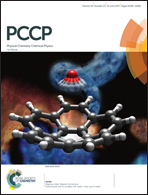Strain effects on phonon transport in antimonene investigated using a first-principles study†
Abstract
Strain engineering is a very effective method to continuously tune the electronic, topological, optical and thermoelectric properties of materials. In this work, strain-dependent phonon transport of recently-fabricated antimonene (Sb monolayers) under biaxial strain is investigated using a combination of first-principles calculations and the linearized phonon Boltzmann equation within the single-mode relaxation time approximation (RTA). It is found that the ZA dispersion of antimonene with strain less than −1% gives imaginary frequencies, which suggests that compressive strain can induce structural instability. Experimentally, it is possible to enhance structural stability by tensile strain. The calculated results show that lattice thermal conductivity increases with strain increasing from −1% to 6%, and lattice thermal conductivity at 6% strain is 5.6 times larger than that at −1% strain at room temperature. It is interesting that lattice thermal conductivity is inversely proportional to the buckling parameter h in a considered strain range. Such a strain dependence of lattice thermal conductivity is attributed to enhanced phonon lifetimes caused by increased strain, while group velocities have a decreased effect on lattice thermal conductivity with increasing strain. It is found that acoustic branches dominate the lattice thermal conductivity over the full strain range. The cumulative room-temperature lattice thermal conductivity at −1% strain converges to a maximum with the phonon mean free path (MFP) at 50 nm, while that at 6% strain becomes as large as 44 μm, which suggests that strain can give rise to very strong size effects on lattice thermal conductivity in antimonene. Finally, the increased lattice thermal conductivity caused by increasing strain can be explained by a reduced polarized covalent bond, inducing weak phonon anharmonicity. These results may provide guidance on fabrication techniques of group-VA element (As, Sb, Bi) monolayers, and offer perspectives on tuning lattice thermal conductivity by the size and strain for applications of thermal management and thermoelectricity.



 Please wait while we load your content...
Please wait while we load your content...